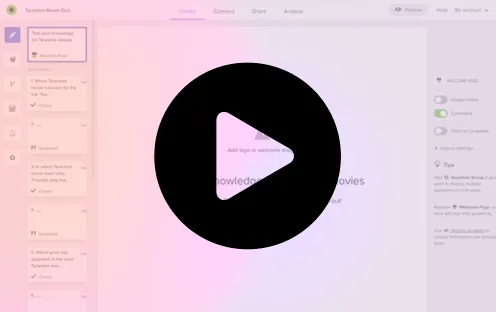
Surveys are invaluable for gathering insights, understanding customer experience, and enhancing business strategies. However, the success of a survey hinges on the questions it contains. Designing survey questions that people want to answer requires finesse, clarity, and an understanding of the respondent’s perspective. An effective strategy to craft survey questions not only capture attention but also inspire thoughtful and engaging responses.
Types of Survey Questions
To enhance your survey response rate, consider employing a variety of question types that cater to different information needs:
- Open-ended Questions
Initiate a conversation by using open-ended questions. These queries encourage more elaborate responses, as respondents can provide feedback through a text box. If you seek a binary yes/no response, opt for a closed-ended question.
Example open-ended questions:
- Please share your thoughts on how we can improve our customer service.
- Could you describe your experience during your recent visit to our store?
- What suggestions do you have for enhancing the user interface of our website?
- Closed-ended Questions
Certain queries require concise responses, such as yes or no. These questions can swiftly gather specific data, which can then be segmented for analysis.
Example closed-ended questions:
- Did you attend the event last week?
- Have you used our mobile app within the last 30 days?
- Rating Questions
Reach for the stars—figuratively or literally. Utilize rating questions to determine how respondents would rate various aspects. This question type is valuable for assessing opinions across a spectrum.
Example rating questions:
- On a scale of 1 to 5, how would you rate the quality of our service?
- How many stars would you assign to our recent film release?
- Please rate the value of the training you received today.
- Likert Scale Questions
Likert scale questions offer insights into respondents’ opinions about specific matters. These questions often feature 5, 7, or 9-point scales and can be quite familiar to survey participants.
Example Likert scale questions:
- To what extent do you agree that the company values employee feedback? a) Strongly Disagree b) Disagree c) Neutral d) Agree e) Strongly Agree
- How satisfied are you with the user interface of our website? a) Very Dissatisfied b) Dissatisfied c) Neutral d) Satisfied e) Very Satisfied
- Multiple Choice Questions
When crafting tests or quizzes, multiple choice questions are indispensable. They allow respondents to select from various answers, concealing the correct response if needed. Additionally, they are suitable for obtaining specific timeframes or event dates. Compact presentation in dropdown menus is another advantage.
Example multiple choice questions:
- What type of vacation do you prefer? a) Beach resort b) Mountain retreat c) City exploration d) Adventure travel
- How often do you exercise? a) Daily b) 2-3 times a week c) Once a week d) Rarely or never
- Picture Choice Questions
A picture is worth a thousand words, and in surveys, it serves multiple functions. Engage respondents with picture choice questions that enhance interactivity and storytelling in your survey.
- Demographic Questions
Demographic questions encompass various formats, from dropdowns to open-ended queries. These questions touch on sensitive topics, including age, gender, and industry details.
Example demographic questions:
- What is your age?
- How do you identify your gender?
- In which industry do you currently work?
Incorporating these diverse question types into your survey can yield richer and more accurate insights, leading to more meaningful analyses and informed decision-making.
In Responsly you can also use ChatGPT for survey and questions creation 🚀
9 tips for writing great survey questions
- Keep It Clear and Concise
The golden rule of survey question design is clarity. Use straightforward language that respondents can easily understand. Avoid jargon, complex sentence structures, or double-barreled questions that touch on multiple topics. A well-defined question minimizes confusion and encourages respondents to provide accurate and meaningful answers. - Start with the Easy Ones
Begin your survey with simple, non-intrusive questions. This helps respondents ease into the process and build momentum. Questions like demographics (age, gender, location) or preferences (favorite color, type of cuisine) are easy to answer and create a positive tone for the rest of the survey. - Use Open-Ended and Closed-Ended Questions Wisely
Mixing open-ended and closed-ended questions provides a balanced survey experience. Closed-ended questions (multiple choice, rating scales) offer quick and quantifiable responses. Open-ended questions encourage respondents to express their opinions in their own words, providing valuable qualitative insights. Strike a balance to maintain respondent engagement and gather comprehensive data. - Avoid Leading or Biased Questions
Leading questions can unintentionally influence respondents to answer in a certain way. For example, “Don’t you think our premium plan is great?” implies a positive response. Opt for neutral phrasing to ensure unbiased and genuine answers. “What are your thoughts on our premium plan?” maintains objectivity. - Make It Relevant and Contextual
Frame questions in a context that resonates with the respondent’s experience. Relate questions to recent interactions, purchases, or experiences with your brand. This personalization demonstrates that you value their input and increases their willingness to participate. - Consider the Respondent’s Perspective
Think about the respondent’s motivation for taking the survey. What’s in it for them? Highlight the benefits of their participation, whether it’s improving a product they use, influencing a service they enjoy, or contributing to a cause they care about. When people understand the value of their input, they’re more likely to engage. - Mix in a Touch of Creativity
Injecting a dose of creativity can make your survey stand out. Use innovative question formats, visual aids, or scenarios that capture respondents’ attention. Creative questions not only make the survey interesting but also stimulate deeper thinking. - Test and Refine
Before launching your survey, conduct a pilot test with a small group to identify any potential issues with question clarity or wording. Analyze their responses and gather feedback on the survey experience. This insight will help you refine your questions for maximum impact. - Express Gratitude
End the survey with a heartfelt thank-you message. Acknowledge the respondents’ time and effort, emphasizing how their input will contribute to meaningful improvements. A genuine expression of gratitude fosters a positive impression and encourages future participation.
How weak questions impact survey results
Weak poll questions can significantly impact poll results’ accuracy and reliability. Weak questions are those that are poorly formulated, ambiguous, leading, or biased. Here’s how they can affect poll results:
- Misinterpretation: Different respondents can interpret Weakly worded questions differently, leading to inconsistent responses. Respondents might misunderstand the question’s intent or focus, resulting in varied answers that don’t accurately reflect their true opinions.
- Ambiguity: Respondents might struggle to provide accurate answers if a question is unclear or lacks specificity. Ambiguous questions can lead to respondents guessing what the question is asking, which can distort the results.
- Leading Questions: Questions containing a bias or steering respondents toward a particular answer can lead to skewed results. Respondents might feel pressured to answer in a certain way, even if it doesn’t align with their true opinions.
- Social Desirability Bias: Weak questions can inadvertently elicit responses that respondents believe are socially acceptable or expected, rather than their genuine views. This can happen when questions touch on sensitive or controversial topics.
- Response Order: The order of questions can influence respondents’ answers. If a weak question is placed before other questions, it might prime respondents to think in a certain way that affects their subsequent responses.
- Acquiescence Bias: Respondents might exhibit a tendency to agree with statements without carefully considering their content. Weak questions can amplify this bias, leading to inflated agreement or disagreement rates.
- Non-Response Bias: If respondents find questions weak or uninteresting, they might skip answering or provide random responses. This can introduce bias if certain types of respondents are more likely to skip certain questions.
- Sampling Bias: Weak questions can result in biased samples if they appeal more to a certain demographic or group. This can lead to an unrepresentative sample of the population being surveyed.
Crafting survey questions that people want to answer is an art that requires careful consideration of language, structure, and respondent motivations. By prioritizing clarity, relevancy, and a participant-centered approach, you can create a survey that captures valuable insights and engages respondents meaningfully. Remember, a well-designed survey is the key to unlocking a treasure trove of actionable data.







